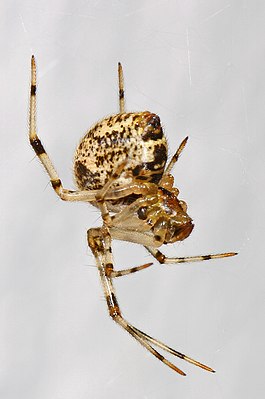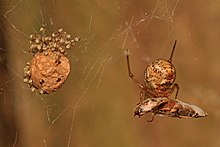Greenhouse spider
| Greenhouse spider | ||||||||||
|---|---|---|---|---|---|---|---|---|---|---|

Greenhouse spider ( Parasteatoda tepidariorum ), female |
||||||||||
| Systematics | ||||||||||
|
||||||||||
| Scientific name | ||||||||||
| Parasteatoda tepidariorum | ||||||||||
| ( CL Koch , 1841) |
The greenhouse spider or greenhouse moon spider ( Parasteatoda tepidariorum , syn .: Achaearanea tepidariorum ) is a species of spider from the family of canopy or ball spiders (Theridiidae). She is one of the greatest representatives of the family in Central Europe . The species probably originally comes from the tropics of South America and has meanwhile established itself as a cultural successor worldwide. The species is not to be confused with the greenhouse jumping spider ( Hansarius adansoni ) from the jumping spider family, which also occurs in greenhouses and originally comes from tropical areas .
description
Males reach a body length of 3.5 to 4 mm, females 4.5 to 7 mm. As with all representatives of the genus, the opisthosoma is taller than long. The coloring is very variable. The prosoma is gray, brownish or black, there is also a yellow form. The basic color of the opisthosoma is accordingly gray, brownish, black or yellow and shows a white, very irregular pattern of spots. The legs are darkly curled.
distribution and habitat
The original home of the species is unclear; it is believed to have come from the tropics of South America, where a number of similar species occur. Today the species is distributed worldwide as a culture follower.
The species occurs in temperate latitudes mainly in frost-free areas such as greenhouses and cellars, but also under bridges or in house passages. In Central Europe, however, the species is increasingly being detected in the wild in regions with less heat, and according to Platen, the species also colonizes tree tops here. Apparently, as it has spread around the world, it has also adapted to a colder climate.
Way of life

In and on buildings, the greenhouse spider usually builds its webs close to the ground. Individual threads pull down from the rather large, loosely woven safety net, which are only provided with glue drops in the lower area. The gray-brown, quite solid and slightly pear-shaped cocoon is hung in the net and guarded. Depending on the food available, the greenhouse spider can produce between 1 and 5 cocoons (on average 3) per season. The young spiders hatch after about 11 days.
Danger
The species is widespread and common in suitable habitats. In Germany it is classified as "safe" in the Red List .
gallery
Female with a captured angle spider
Left picture: A parasitic wasp of the species Zatypota albicoxa lays an egg on the abdomen of a greenhouse spider . The larva of the wasp feeds on the spider after hatching.
swell
Individual evidence
- ↑ K. Tanaka: Photoperiodic Control of Diapause and Climatic Adaptation of the House Spider, Achaearanea tepidariorum (Araneae, Theridiidae). Functional Ecology 6, No. 5; 1992: pp. 545-552. doi : 10.2307 / 2390051 .
- ^ K. Miyashita: Egg production of Achaearanea tepidariorum (CL Koch) (Araneae, Theridiidae) in the field in Japan. The Journal of Arachnology, Issue 15; 1987: pp. 130-132.
literature
- Heiko Bellmann: Cosmos Atlas Arachnids of Europe . 3rd edition, 2006. Kosmos, Stuttgart. ISBN 978-3-440-10746-1
- Ralph Platen, Bodo von Broen, Andreas Herrmann, Ulrich M. Ratschker & Peter Sacher: Total species list and red list of spiders, harvestmen and pseudoscorpions of the state of Brandenburg (Arachnida: Araneae, Opiliones, Pseudoscorpiones) with information on frequency and ecology. Nature conservation and landscape management in Brandenburg 8, booklet 2 (supplement); 1999.
Web links
Greenhouse spider in the World Spider Catalog











